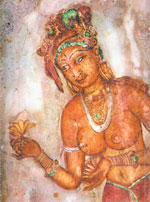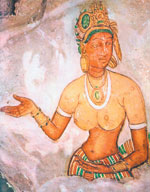|
Gavshaka
moves over to study early Sinhalese paintings
Sigiriya is situated between the ancient Sinhalese capitals of Anuradhapura, Polonnaruwa and Kandy. Just as much as it is a rock fortress from where King Kasyapa (473- 491 A.D) ruled, it gives us the earliest paintings done by our own artists in a very good state of preservation. Sigiriya (lion rock) is world famous for its frescoes and the mirror wall where visitors have described what they felt about the frescoes they saw and admired. While Sigiriya is a great engineering feat, it is also a fine art gallery. It is believed that there were as much as 500 paintings but only 21 remain today. The drawings have been done free hand and corrections done by the artist can be seen clearly. The frescoes are very similar to the ones seen at the famous Ajanta caves in India. Several scholars have interpreted the frescoes in different ways. To some, they depict female members of the royal household. Since most of them are in pairs, these have been described as portraying a queen and a maid or a lady-in-waiting. Difference in colour indicates that they are different personalities, these scholars argue. Pioneer archaeologist, H C P Bell says they are ladies of the king’s court on their way to a nearby temple because they are carrying flowers and moving in one direction. Another theory is that they are Kasyapa’s queens with attendants bringing floral offerings to a shrine, which seems to be located in Thusitha heaven, since the figures appear to be half immersed in the clouds denoting that they are in heavenly spheres. Are they Kasyapa’s queens mourning for the royal husband, was another theory about the damsels. To renowned interpreter of Asian art and culture, Dr Ananda Coomaraswamy, the ladies in the frescoes are Apsaras (celestial nymphs) because the figures are cut off at the waists by conventional clouds. Dr Senerat Paranavitana, the respected archaeologist says that the figures represent Lightning Princesses (vijju kumari) and Cloud Damsels (meghalata). He interprets the whole of Sigiriya as the abode of God Kuvera. Even if the
artist depicted celestial beings, he was obviously influenced by
the queens in the King’s court when drawing the figures. Cornets
and tiaras crown the head; flowers and ribbons adorn the hair; heavy
ornaments and jewellery are worn in the ears, neck, breast, arms
and wrists. There is a feeling of movement in that the bodies are
bent forward or sideways. The eyes are cast down with either a downward
look or a side long glance. The eye lids being narrow, there is
a distinct look of them being half closed. These belong
to the eighth century onwards. In beautiful poetry, they gave their
own interpretation. Some of them said they were Kasyapa’s
wives. “I saw the long-eyed ones of the King who, being separated
from their lord, are worn out with grief and those eyes are comparable
to full-blown lilies”, one Piyal has written. Another wrote
that the golden-coloured ones in the caves appeared as if they were
hurling themselves down from the summit of the rock, being unable
to console their hearts as, indeed, the King had died. |
||||
Copyright © 2001 Wijeya Newspapers
Ltd. All rights reserved. |

